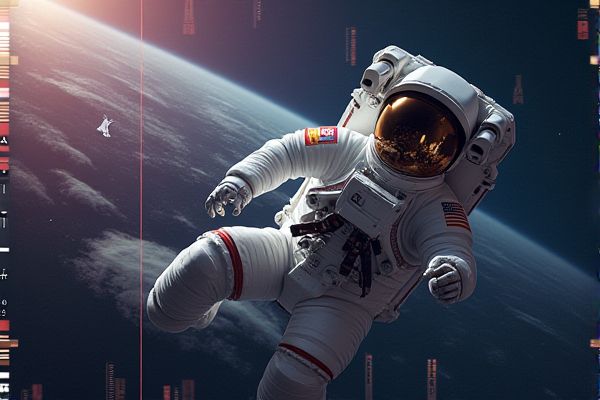
AI enhances mission planning by analyzing vast datasets to optimize flight paths and resource allocation. Advanced algorithms assist in spacecraft navigation, improving accuracy and safety during critical maneuvers. AI-driven robots and drones conduct maintenance tasks on space stations, reducing human workload and minimizing risks. Machine learning analyzes data from space missions, providing insights that advance our understanding of the universe and facilitating future explorations.
AI usage in astronautics
Autonomous Navigation
The application of AI in astronautics offers the potential for enhanced autonomous navigation systems. By integrating AI algorithms, spacecraft can process real-time data to make more informed decisions, improving mission safety. For example, NASA's Artemis program utilizes advanced AI technologies to optimize trajectory and resource management. The possibility of reducing human error during space missions presents a significant advantage for future exploration endeavors.
Spacecraft System Monitoring
AI technologies can enhance spacecraft system monitoring by analyzing vast amounts of sensor data in real-time. With applications such as anomaly detection, AI can identify potential issues early, reducing the risk of system failures during missions. The integration of AI in monitoring systems can lead to improved operational efficiency, as seen in projects by organizations like NASA. By utilizing machine learning algorithms, spacecraft can adapt to changing conditions in space, increasing mission success rates.
Predictive Maintenance
AI usage in astronautics presents opportunities for improved predictive maintenance of spacecraft systems. By analyzing large datasets from spacecraft operations, AI algorithms can identify patterns and predict potential failures. For instance, NASA's Jet Propulsion Laboratory employs machine learning to enhance the reliability of Mars rovers through early detection of system anomalies. This capability could lead to increased mission success rates and reduced downtime in future space explorations.
Space Debris Tracking
AI can enhance space debris tracking by analyzing large datasets to predict debris trajectories. Organizations like NASA utilize machine learning algorithms to improve the accuracy of predictions. This technology may reduce the risk of collisions between spacecraft and space debris, thereby ensuring safer missions. The potential for AI to streamline data processing in astronautics highlights the advantages of employing advanced technology in space exploration.
Extraterrestrial Exploration
AI can significantly enhance spacecraft navigation and decision-making processes in astronautics. For instance, NASA's use of AI in the Perseverance rover allows for autonomous navigation on Mars, potentially reducing the need for constant human oversight. The integration of AI in analyzing extraterrestrial data may lead to quicker identification of resources, increasing the chances of successful missions. This technological advancement can improve the overall efficiency of exploration efforts, paving the way for future human settlement on other planets.
Crew Health Monitoring
AI can significantly enhance crew health monitoring in astronautics by analyzing real-time data on astronaut physical and mental well-being. This technology can identify patterns indicating potential health risks, allowing for timely interventions. For example, NASA's ongoing research into AI-driven systems aims to optimize life support and medical care in space missions. Implementing such AI systems could improve the chances of maintaining astronaut health during long-duration space travel.
Mission Planning Optimization
AI can enhance mission planning optimization in astronautics by analyzing vast datasets to identify the most efficient trajectories and resource allocations. For example, NASA's use of AI algorithms for scheduling spacecraft operations demonstrates the potential for improved mission outcomes. This technology can reduce human error and save time, which increases the likelihood of mission success. The chance of utilizing AI tools in planning future missions could lead to significant advancements in space exploration efficiency.
Image and Data Analysis
AI has the potential to enhance astronautics through improved image and data analysis, enabling quicker and more accurate decision-making. For example, AI algorithms can process vast amounts of data from satellite imagery to identify suitable landing sites on celestial bodies. This technology can increase the chances of successful missions by minimizing risks associated with human error. Additionally, institutions like NASA are exploring AI applications to optimize mission planning and resource allocation.
Communication Efficiency
AI can enhance communication efficiency in astronautics by enabling real-time data processing and decision-making. For instance, NASA might utilize AI algorithms to optimize the transmission of information between spacecraft and mission control. This capability could lead to reduced signal delays and improved reliability in critical missions. The chance of successfully managing complex spacecraft operations increases with the integration of advanced AI systems.
Resource Management
AI can enhance resource management in astronautics by optimizing the allocation of supplies and energy aboard spacecraft. For instance, NASA's Artemis program could leverage AI systems to monitor and predict usage patterns, ensuring efficient resource distribution. This could minimize waste and reduce the need for resupply missions. The potential advantages include lower costs and increased mission success rates in deep space exploration.
 techknowy.com
techknowy.com